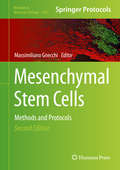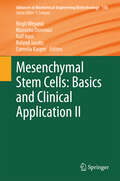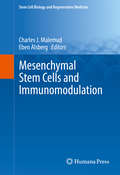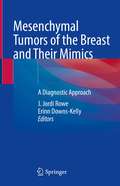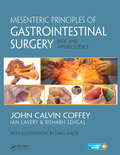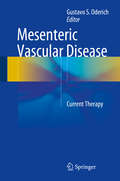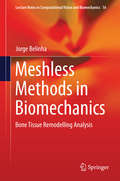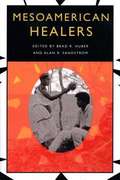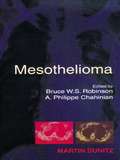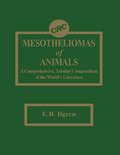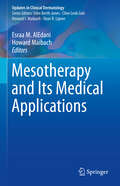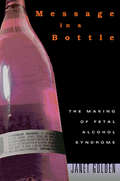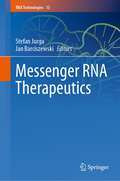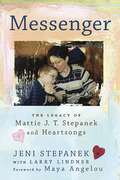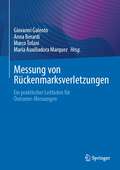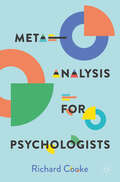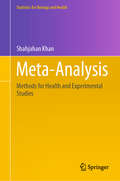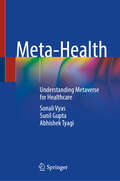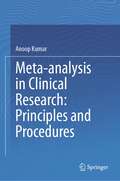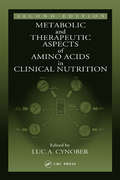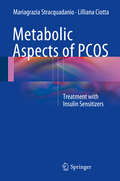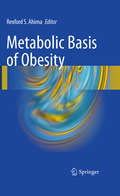- Table View
- List View
Mesenchymal Stem Cells
by Massimiliano GnecchiThis volume aims to outline the current status of the Mesenchymal Stem Cells(MSC) field in regenerative medicine and to propose clear and reproducible protocols to better define the identity, function and use of these cells that are today, more than ever, "under the spotlight". Mesenchymal Stem Cells: Methods and Protocols, Second Edition is organized into four sections. The first guides the reader through a series of state-of-the-art reviews summarizing the use of MSC for the treatment of various diseases. The other three sections are a collection of methodological chapters covering several aspects: isolation and characterization of MSC; expansion of MSC for clinical use; production and characterization of the MSC secretome. Written in the highly successful Methods in Molecular Biology series format, the method chapters include introductions to their respective topics, complete lists of the necessary materials and reagents, step-by-step, readily reproducible laboratory protocols, and tips on troubleshooting which will help the researcher to avoid known pitfalls. Authoritative and cutting-edge, Mesenchymal Stem Cells: Methods and Protocols, Second Edition, aims to ensure successful results in the further study of this vital field.
Mesenchymal Stem Cells - Basics and Clinical Application I
by Birgit Weyand Ralf Hass Roland Jacobs Massimo Dominici Cornelia KasperProspective Isolation and Characterization of Human Bone Marrow-Derived MSCs, by A. Harichandan, K. Sivasubramaniyan, H.-J. Bühring Urine as a Source of Stem Cells, by Christina Benda, Ting Zhou, Xianming Wang, Weihua Tian, Johannes Grillari, Hung-Fat Tse, Regina Grillari-Voglauer, Duanqing Pei, Miguel A. Esteban Expansion of Mesenchymal Stem/Stromal Cells under Xenogenic-Free Culture Conditions, by Sven Kinzebach, Karen Bieback Adipose-Derived Mesenchymal Stem Cells: Biology and Potential Applications, by Danielle Minteer, Kacey G Marra, J Peter Rubin Potential for Osteogenic and Chondrogenic Differentiation of MSC, by Antonina Lavrentieva, Tim Hatlapatka, Anne Neumann, Birgit Weyand, Cornelia Kasper Potential for Neural Differentiation of Mesenchymal Stem Cells, by Letizia Ferroni, Chiara Gardin, Ilaria Tocco, Roberta Epis, Alessandro Casadei, Vincenzo Vindigni, Giuseppe Mucci, Barbara Zavan Migratory Properties of Mesenchymal Stem Cells, by Thomas Dittmar, Frank Entschladen Dissecting Paracrine Effectors for Mesenchymal Stem Cells, by Stefania Bruno, Federica Collino, Ciro Tetta, Giovanni Camussi Proteomics Approaches in the Identification of Molecular Signatures of Mesenchymal Stem Cells, by Yin Xiao, Jiezhong Chen Does the Adult Stroma Contain Stem Cells?, by Richard Schäfer
Mesenchymal Stem Cells and Immunomodulation
by Charles J. Malemud Eben AlsbergThis essential volume explores mesenchymal stem cells (MSCs) and their potential to suppress immune-mediated inflammation. The chapters examine applications in autoimmune diseases such as lupus, rheumatoid arthritis and multiple sclerosis; blood cancers such as leukemia and lymphoma; and reproductive complications, specifically pre-term labor and use of MSCs in vitro and in animal models to discover methods of suppressing the causal inflammatory response. It also further defines the methodologies required to develop research on MSCs in vitro into established preclinical animal models including those which are proven replicas of autoimmunity and pre-term labor, to name but two. Mesenchymal Stem Cells and Immunomodulation, part of Springer's Stem Cell Biology and Regenerative Medicine, is an invaluable resource for researchers and clinicians working with stem cells, autoimmune disease, oncology, and reproductive medicine.
Mesenchymal Tumors of the Breast and Their Mimics: A Diagnostic Approach
by J. Jordi Rowe Erinn Downs-KellyThis book utilizes a uniform approach to provide a framework for the diagnosis of mesenchymal tumors of the breast while highlighting their mimics. Emphasis is placed on a practical approach to the morphologic interpretation and useful ancillary tests while exploring the differential diagnoses in depth. Given the overall low incidence of mesenchymal lesions of the breast along with their mimics, surgical pathologists are not consistently exposed to these spindle cell lesions. Compounding this problem is the broad differential that these lesions engender, with entities ranging from reactive/reparative lesions to poorly differentiated spindle cell malignancies. Furthering the challenge, the diagnoses may be complicated by fixation issues, sampling method, small sample size, lack of clinical history and prior treatment effects. The goal of this book is to introduce readers to the spectrum of these lesions while providing a systematic approach that helps establish accurate diagnoses that in turn drive appropriate clinical follow up and treatment. Chapters cover the spectrum of benign and malignant mesenchymal tumors and their mimics that are found in the breast in an easy to read format with richly detailed images to aid in diagnoses. The text also discusses practical components to aid in establishing and evaluating the differential diagnosis. Given how morphologically and clinically diverse these lesions are, Mesenchymal Tumors of the Breast and Their Mimics provides a construct for integrating the varied components that go into establishing a diagnosis for this challenging aspect of breast pathology.
Mesenteric Principles of Gastrointestinal Surgery: Basic and Applied Science
by John Calvin Coffey Rishabh Sehgal Dara WalshMesenteric-based gastrointestinal and colorectal surgery has been practiced internationally for over a century. However, it is not yet universally adopted, and considerable variations exist. Such variations are explained by the historical disparity that has persisted between anatomic and surgical approaches to the intestinal mesentery. While mesenteric-based surgery is far from new, it is remarkable that its anatomic basis has only recently been formally described. This means that key mesenteric principles of intestinal and colorectal surgery can now be taught, conducted and developed, in an entirely standardised manner. This book is composed of two parts. In this new book surgical anatomy, activities and operations are carefully defined, and beautifully illustrated, to enable all surgeons to conduct mesenteric-based intestinal and colorectal surgery, appropriately and with confidence.
Mesenteric Vascular Disease
by Gustavo S. OderichThis book represents the first comprehensive textbook devoted to the standard of care, current guidelines and innovations in the field of mesenteric vascular disease. The book reviews imaging modalities, diagnostic work up, physiologic tests, traditional open surgical techniques and novel endovascular approaches. Technical aspects of both open surgical and endovascular techniques are provided by experts in the field, with illustrations and photographs of key steps for each type of procedure. Results of epidemiologic studies and national databases are summarized, as well as large institutional experiences. An evidence-based approach is used for recommendations regarding best therapies. Diagnostic approaches including imaging and novel physiologic tests, including gastric tonometry and oxygen light spectroscopy are covered. Mesenteric Vascular Disease: Current Therapy will serve as a very useful resource for clinicians, surgeons, interventionalists, gastroenterologists and researchers dealing with and interested in mesenteric vascular diseases.
Meshless Methods in Biomechanics
by Jorge BelinhaThis book presents the complete formulation of a new advanced discretization meshless technique: the Natural Neighbour Radial Point Interpolation Method (NNRPIM). In addition, two of the most popular meshless methods, the EFGM and the RPIM, are fully presented. Being a truly meshless method, the major advantages of the NNRPIM over the FEM and other meshless methods, are the remeshing flexibility and the higher accuracy of the obtained variable field. Using the natural neighbour concept, the NNRPIM permits to determine organically the influence-domain, resembling the cellulae natural behaviour. This innovation permits the analysis of convex boundaries and extremely irregular meshes, which is an advantage in the biomechanical analysis, with no extra computational effort associated. This volume shows how to extend the NNRPIM to the bone tissue remodelling analysis, expecting to contribute with new numerical tools and strategies in order to permit a more efficient numerical biomechanical analysis.
Mesmerized
by Alissa WalserMozart's Vienna. A crucible for scientific experimentation and courtly intrigue, as Europe's finest minds vie for imperial favour. In a colourful, chaotic private hospital that echoes with the shrieks of hysterical patients, Franz Anton Mesmer is developing a series of controversial cure-alls for body and mind. When he is asked to help restore the sight of a blind musical prodigy favoured by the Empress herself, he senses that fame, and even immortality, is within his grasp. Mesmer knows that he will have to gain her trust if he is to open her eyes. But at what cost to her fragile talent? And will their intimacy result in scandal?
Mesmerized
by Alissa WalserMozart's Vienna. A crucible for scientific experimentation and courtly intrigue, as Europe's finest minds vie for imperial favour. In a colourful, chaotic private hospital that echoes with the shrieks of hysterical patients, Franz Anton Mesmer is developing a series of controversial cure-alls for body and mind. When he is asked to help restore the sight of a blind musical prodigy favoured by the Empress herself, he senses that fame, and even immortality, is within his grasp. Mesmer knows that he will have to gain her trust if he is to open her eyes. But at what cost to her fragile talent? And will their intimacy result in scandal?
Mesoamerican Healers
by Brad R. Huber Alan R. SandstromHealing practices in Mesoamerica span a wide range, from traditional folk medicine with roots reaching back into the prehispanic era to westernized biomedicine. These sometimes cooperating, sometimes competing practices have attracted attention from researchers and the public alike, as interest in alternative medicine and holistic healing continues to grow.<P><P>Responding to this interest, the essays in this book offer a comprehensive, state-of-the-art survey of Mesoamerican healers and medical practices in Mexico and Guatemala. The first two essays describe the work of prehispanic and colonial healers and show how their roles changed over time. The remaining essays look at contemporary healers, including bonesetters, curers, midwives, nurses, physicians, social workers, and spiritualists. Using a variety of theoretical approaches, the authors examine such topics as the intersection of gender and curing, the recruitment of healers and their training, healers' compensation and workload, types of illnesses treated and recommended treatments, conceptual models used in diagnosis and treatment, and the relationships among healers and between indigenous healers and medical and political authorities.
Mesothelioma
by Bruce W.S. Robinson A. Philippe ChahinianMesothelioma used to be a rare disease, but because of the widespread use of asbestos it has now been described as an epidemic around the world. The disease has proven exceptionally resistant to common forms of treatment (chemotherapy, radiotherapy and surgery). Mesothelioma has a very aggressive natural history with a median survival of around 9 m
Mesothelioma: From Research to Clinical Practice
by Emilio Bombardieri Giovanni Luca Ceresoli Maurizio D’IncalciThis book offers an updated review of malignant mesothelioma, including the latest advances in our understanding of its genetic control and molecular biology, as well as pre-clinical and clinical research. It also presents state-of-the-art diagnostic approaches and therapeutic options, and an open discussion on the future prospects for patient management. Malignant mesothelioma is an enormous global health problem related to asbestos exposure. Despite the best efforts of scientists and oncologists, the prognosis for those affected remains poor. Due to anatomical characteristics and non-specific symptoms, the diagnosis of mesothelioma at an early stage is often difficult, while surgery and radiotherapy are only of limited use, even if some multimodality approaches seem promising. In turn, medical treatments are sometimes successful in tumor control, but have little impact on overall survival. However, advances in our understanding of the disease’s biology, together with the availability of new drugs and combinations, make mesothelioma an essential and highly topical field for pre-clinical and clinical studies. This book is subdivided into four parts: epidemiology and preclinical data, diagnosis, therapy, and extrathoracic mesothelioma. It highlights the progress made in a variety of areas – e.g. in vitro and in vivo experimental models, genetics, environment, biomarkers, targeting agents, immunotherapy, metabolic imaging and ongoing clinical trials – and describes the standard clinical management of mesothelioma patients, including those with extra-thoracic localizations. Given its scope, the book offers an invaluable tool for researchers, oncologists and clinicians alike.
Mesotheliomas of Animals: A Comprehensive, Tabular Compendium of the World's Literature
by Edward B. IlgrenMesotheliomas of Animals is the first book to provide a comprehensive compilation of the diverse and often disparate literature regarding animal mesotheliomas. The compendium presents evidence to support the existence of "background" and "threshold," both of which are concepts central to the controversy surrounding nonasbestos-related mesotheliomas. Examples of "background" tumors (those which are nonasbestos-related) are described in detail, and indications of "threshold" for the induction of mesotheliomas following exposure to asbestiform and nonasbestiform agents are evident from the "positive dose-response" studies that are discussed. This compendium also allows for easy comparison of tumor yields elicited in "inoculation" studies performed with the same fiber types at similar doses. These comparisons often demonstrate markedly different tumor yields and highlight the limitations of injection techniques for fiber safety assessment. Mesotheliomas of Animals will be an essential reference for industrial hygienists, environmental lawyers, cancer researchers, and pulmonary scientists. It will be particularly useful to anyone involved with the design of fiber safety tests or with developing experimental models and protocols to assess the manner in which mesotheliomagenesis occurs.
Mesotherapy and Its Medical Applications (Updates in Clinical Dermatology)
by Howard Maibach Esraa M. AlEdaniThis book is the first authoritative book volume dedicated to the application of Mesotherapy in dermatology. This book provides an up-to-date and comprehensive overview of the basic structural component of Mesotherapy and its constitution from the chemical side of view, then we will discuss its role in cosmetic dermatology, facial rejuvenation, its anti-aging properties, and its role with hyaluronic acid and mesoneedling therapy for facial youthfulness. This volume will describe interplay of mesotherapy and other dermatological diseases such as alopecia hair loss, melasma, acne, psoriasis, and eczema. Chapters will address key issues, such as mesotherapy complications and urticaria that are caused because of it. In addition, the book will discuss severe acute caffeine poisoning due to intradermal mesotherapy injections and the use of mesotherapy as a lucrative business in the cosmetic industry. This book will be a valuable resource to dermatologists, general practitioners, dermatology residents, and medical students.
Message in a Bottle: The Making of Fetal Alcohol Syndrome
by Janet GoldenA generation has passed since a physician first noticed that women who drank heavily while pregnant gave birth to underweight infants with disturbing tell-tale characteristics. Women whose own mothers enjoyed martinis while pregnant now lost sleep over a bowl of rum raisin ice cream. In Message in a Bottle, Janet Golden charts the course of Fetal Alcohol Syndrome (FAS) through the courts, media, medical establishment, and public imagination. Long considered harmless during pregnancy (doctors even administered it intravenously during labor), alcohol, when consumed by pregnant women, increasingly appeared to be a potent teratogen and a pressing public health concern. Some clinicians recommended that women simply moderate alcohol consumption; others, however, claimed that there was no demonstrably safe level for a developing fetus, and called for complete abstinence. Even as the diagnosis gained acceptance and labels appeared on alcoholic beverages warning pregnant women of the danger, FAS began to be de-medicalized in some settings. More and more, FAS emerged in court cases as a viable defense for people charged with serious, even capital, crimes and their claims were rejected. Golden argues that the reaction to FAS was shaped by the struggle over women's relatively new abortion rights and the escalating media frenzy over "crack" babies. It was increasingly used as evidence of the moral decay found within marginalized communities--from inner-city neighborhoods to Indian reservations. With each reframing, FAS became a currency traded by politicians and political commentators, lawyers, public health professionals, and advocates for underrepresented minorities, each pursuing separate aims.
Messenger RNA Therapeutics (RNA Technologies #13)
by Jan Barciszewski Stefan JurgaThis book focuses on the fundamentals and applications of messenger RNA (mRNA)-based therapeutics and discusses the strengths and key challenges of this emerging class of drugs. In the past 30 years, extensive research and technological development in many areas have contributed to the emergence of in vitro transcribed mRNA as a therapeutic that has now reached clinical testing. Formulations that protect the mRNA from nucleases and accelerate its cellular uptake, combined with improvements to the mRNA molecules themselves, have been critical advancements for mRNAs to become viable therapeutics. Though once regarded as a serious impediment, the transient nature of mRNA technology is now considered a major advantage in making mRNA therapies safe and, ultimately, a potential game changer in the field of medicine. This new book in the RNA Technologies series provides a state-of-the-art overview on the emerging field of mRNA therapeutics covering essential strategies for formulation, delivery, and application. It also reviews the promising role in cancer immunotherapy, respiratory diseases, and chronic HBV infection and discusses RNA vaccines in light of the current COVID-19 pandemic. mRNA-based approaches have great potential to revolutionize molecular biology, cell biology, biomedical research, and medicine. Thus, this handbook is an essential resource for researchers in academia and industry contributing to the development of this new area of therapeutics.
Messenger: The Legacy of Mattie J. T. Stepanek and Heartsongs
by Jeni Stepanek Larry LindnerIn Messenger, Jeni Stepanek shares the inspiring story of her son's life. Mattie was born with a rare disorder called Dysautonomic Mitochondrial Myopathy, and Jeni was advised to institutionalize him. Instead, she nurtured a child who transformed his hardships into a worldwide message of peace and hope.
Messung von Rückenmarksverletzungen: Ein praktischer Leitfaden für Outcome-Messungen
by Giovanni Galeoto Anna Berardi Marco Tofani Maria Auxiliadora MarquezDieses Buch beschreibt validierte Ergebnismessungen für die internationale Bevölkerung mit Rückenmarksverletzungen. Auf der Grundlage strenger systematischer Überprüfungen von ca. 80.000 wissenschaftlichen Artikeln stellen die Autoren Bewertungsinstrumente für verschiedene klinische Anwendungen in den Gesundheitswissenschaften vor und berücksichtigen dabei Parameter wie Validität, Zuverlässigkeit und Ansprechbarkeit.Für die Entwicklung der klinischen Praxis und der Forschung ist es wichtig, dass praktische und geeignete Messinstrumente allgemein akzeptiert werden; dies würde Vergleiche und Meta-Analysen von qualitativ hochwertigen randomisierten kontrollierten Studien mit Menschen mit dieser immer häufigeren Verletzung ermöglichen.Dieses Buch unterstreicht die Notwendigkeit eines Konsenses unter den Forschern darüber, welche Instrumente eingehend untersucht oder an andere nationale Kontexte angepasst werden müssen, oder welche Messinstrumente standardisiert werden sollten, um universelle Normen und Standards für die Leistung von Menschen mit Rückenmarksverletzungen zu entwickeln. Es bietet einen wertvollen praktischen Leitfaden für Kliniker, Rehabilitationsfachleute und Pflegepersonal, wird aber auch Forschern helfen, mehr Vertrauen in die Verwendung gültiger und zuverlässiger Bewertungsinstrumente für vergleichbare klinische Studien zu gewinnen.
Meta-Analysis for Psychologists
by Richard CookeThis textbook provides a comprehensive, user-friendly guide to meta-analysis and how to conduct it, using open source software and based on examples commonly found in the field of psychology. Meta-analysis is a key tool used in systematic literature reviews to synthesize research findings across studies, but despite being relatively straightforward to perform, it remains underused by psychologists. In the first section the reader is introduced to key ideas that underlie meta-analysis and how it might be best employed. Following this the reader is guided through how to run a meta-analysis of correlational studies and experimental studies using the free and open statistical software JAMOVI. In the concluding section Professor Cooke considers common issues, key debates and examines the relative merits of different analyses and different software packages.Covers theory, key issues and step-by-step demonstrationsIncludes examples worked examples familiar to psychologists and datasetsCompanion videos demonstrate the methods outlinedIt will provide a valuable new resource for postgraduate students and researchers in the behavioural and social sciences looking to enhance their methodological skills.
Meta-Analysis: Methods for Health and Experimental Studies (Statistics for Biology and Health)
by Shahjahan KhanThis book focuses on performing hands-on meta-analysis using MetaXL, a free add-on to MS Excel. The illustrative examples are taken mainly from medical and health sciences studies, but the generic methods can be used to perform meta-analysis on data from any other discipline. The book adopts a step-by-step approach to perform meta-analyses and interpret the results. Stata codes for meta-analyses are also provided. All popularly used meta-analytic methods and models – such as the fixed effect model, random effects model, inverse variance heterogeneity model, and quality effect model – are used to find the confidence interval for the effect size measure of independent primary studies and the pooled study. In addition to the commonly used meta-analytic methods for various effect size measures, the book includes special topics such as meta-regression, dose-response meta-analysis, and publication bias. The main attraction for readers is the book’s simplicity and straightforwardness in conducting actual meta-analysis using MetaXL. Researchers would easily find everything on meta-analysis of any particular effect size in one specific chapter once they could determine the underlying effect measure. Readers will be able to see the results under different models and also will be able to select the correct model to obtain accurate results.
Meta-Health: Understanding Metaverse for Healthcare
by Sunil Gupta Sonali Vyas Abhishek TyagiMetaverse is an emerging trend these days. It reflects in every field, like education, entertainment, business, and even healthcare. As we can experience, the Healthcare industry is constantly transforming due to emerge of new trends and technologies like moving from X-Rays to digital reports and from telehealth to Virtual Reality. It is a vast digital shift from regular practices to innovative techniques for efficient healthcare services. Metaverse plays a significant role in changing healthcare because it connects innovative technologies like Artificial Intelligence, Virtual Reality, Augmented Reality, IoT, Web 3.0, Quantum Computing, Robotics, etc. This book discusses the application area of utilizing Metaverse in Healthcare services. It focuses on various research trends and technologies related to implementing a metaverse in healthcare systems. It also covers challenges, emerging trends and techniques, and future directions for meta-healthcare systems.
Meta-analysis in Clinical Research: Principles and Procedures
by Anoop KumarThis book provides conceptual information on the various processes involved in meta-analysis. It examines the importance of meta-analysis for the analyses of clinical data to draw a valid conclusion using suitable software. The initial sections of the book introduce meta-analysis, how to perform a systematic literature review (SLR), quality assessment of studies, extraction, and analysis of data. The subsequent section of the book contains information on advanced topics including, meta-regression, network meta-analysis, issues, mistakes, and future perspectives. In summary, the book provides a statistical method for combining the results of different studies on the same topic and resolving conflicts among studies. This book is written with the intent to allow a wide range of readers including students, researchers, and health care professionals, including physicians, nurses, pharmacists, and paramedical, and is also helpful for a beginner who would like to do a meta-analysis.
Metabolic & Therapeutic Aspects of Amino Acids in Clinical Nutrition
by Luc A. CynoberThe first edition of this innovative book brought a new perspective to the metabolic and therapeutic aspects of amino acids in clinical nutrition. Since its publication, a number of very important advances have been made in the field and interesting new findings have emerged. Until now, no reference has fully explored the promising new developments
Metabolic Aspects of PCOS
by Mariagrazia Stracquadanio Lilliana CiottaThis book on the metabolic aspects of polycystic ovary syndrome (PCOS) reviews the scientific evidence for the key etiological role of insulin resistance in the pathogenesis of PCOS. It also presents a new clinical and diagnostic approach and clearly explains the value of insulin-sensitizing agents, or "insulin sensitizers," in reducing hyperandrogenism and improving fertility outcome. Detailed information is provided on the use of insulin sensitizers such as metformin and inositol and suitable therapeutic protocols are described. All too often, PCOS is treated by gynecologists only as an endocrine disorder, without recognition of the very important part that insulin plays in the syndrome. Practitioners will find this book to be a valuable source of information on PCOS as a metabolic syndrome and a comprehensive guide to achieving good treatment results.
Metabolic Basis of Obesity
by Rexford S. AhimaThe obesity epidemic has generated immense interest in recent years due to the wide-ranging and significant adverse health and economic consequences that surround the problem. Much attention has been focused on behaviors that lead to obesity, in particular to over consumption of energy-dense food and to sedentary lifestyle. However, obesity is an extremely complex condition with poorly defined pathogenesis. Thanks to greatly enhanced research in the area, the discovery of pathways in the brain and peripheral organs that mediate energy homeostasis has provided a framework for understanding the biological basis of obesity. Metabolic Basis of Obesity adds an important new dimension to the growing literature on obesity by offering a comprehensive review of specifically how metabolic imbalance culminates in obesity. Developed by a team of expert authors, this important title discusses the principles of energy balance, genetics of body weight regulation, hormones and adipokines, and metabolic pathways in the brain, liver, muscle and fat, to name just several of the areas covered. The book also examines the connection between obesity and diabetes, cardiovascular disease and other complications. Current and future diagnostic and treatment strategies are also reviewed. Comprehensive and timely, Metabolic Basis of Obesity is an essential reference for understanding the burgeoning problem of obesity.
